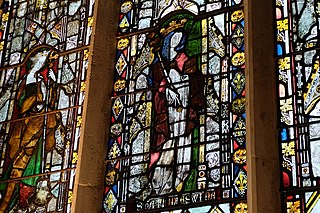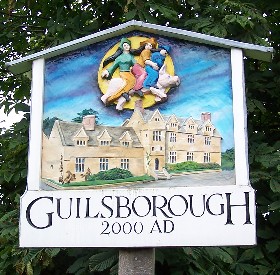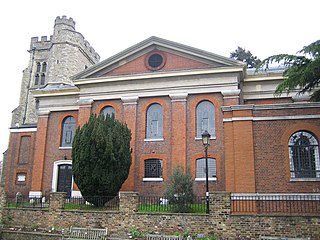
St Pandionia (died c. 904; also known as Pandiona or Pandwyna) was an Anglo-Saxon nun and Christian saint. Her feast day is 26 August.

St Pandionia (died c. 904; also known as Pandiona or Pandwyna) was an Anglo-Saxon nun and Christian saint. Her feast day is 26 August.
Little is known about her, but by tradition she was the daughter of a minor Irish prince or Scottish king who fled to England to escape her father following persecution of her Christianity and her desire to serve God in celibacy. She sought refuge with a kinswoman who was prioress of a nunnery in Eltisley, Cambridgeshire and there became known for her holiness, though other sources suggest she lived for a time in Usselby, Lincolnshire. [1] Following her death in around 904 she was buried near a well which bore her name, and canonized soon after. [2]
In 1344 her remains were exhumed and reburied beneath the altar of the parish church in Eltisley, which is still dedicated to 'St Pandionia and St John the Baptist'. It is rare for a parish church to retain the relics of a saint, as the much wealthier monastic institutions would usually acquire them. In 1575, in the fervour of the Protestant Reformation which sought to rid the church's association with saints, the remains of her well were destroyed by the Rector Roger Palmer amid claims that they were the site of “idolatrous and popish practices”. The site of the well is no longer known. [2] [3]

Catherine of Alexandria, or Katharine of Alexandria, also known as Saint Catherine of Alexandria, Saint Catherine of the Wheel and The Great Martyr Saint Catherine, is, according to tradition, a Christian saint and virgin, who was martyred in the early 4th century at the hands of the emperor Maxentius. According to her hagiography, she was both a princess and a noted scholar who became a Christian around the age of 14, converted hundreds of people to Christianity and was martyred around the age of 18. More than 1,100 years after Catherine's martyrdom, Joan of Arc identified her as one of the saints who appeared to and counselled her.

Eadburh was the daughter of King Edward the Elder of England and his third wife, Eadgifu of Kent.

Bierton is a village in Buckinghamshire, England, about half a mile northeast of the town of Aylesbury. It is mainly a farming parish. The hamlets of Broughton, Broughton Crossing and Burcott lie within Bierton with Broughton civil parish part of Aylesbury Vale district and form part of the Aylesbury Urban Area.

Æthelthryth was an East Anglian princess, a Fenland and Northumbrian queen and Abbess of Ely. She is an Anglo-Saxon saint, and is also known as Etheldreda or Audrey, especially in religious contexts.

Saint Frithuswith was an English princess and abbess. She is credited with establishing a religious site later incorporated into Christ Church in Oxford – Frithuswith was the first abbess of this Oxford double monastery. Frithuswith was the daughter of a Mercian sub-king named Dida of Eynsham, whose lands occupied western Oxfordshire and the upper reaches of the River Thames. Dida is known to have endowed churches in Bampton and Oxford.

Werburgh was an Anglo-Saxon princess who became the patron saint of the city of Chester in Cheshire. Her feast day is 3 February.

Holkham is a village and civil parish in the north of the county of Norfolk, England. Besides the small village, the parish includes the major stately home and estate of Holkham Hall and an attractive beach at Holkham Gap. The three lie at the centre of the Holkham National Nature Reserve.

Guilsborough is a village and civil parish in the Daventry district of the county of Northamptonshire in England. At the time of the 2001 census, the parish's population was 882 people, reducing to 692 at the 2011 Census.

Littlemore is a district and civil parish in Oxford, England. The civil parish includes part of Rose Hill. It is about 2 1⁄2 miles (4 km) southeast of the city centre of Oxford, between Rose Hill, Blackbird Leys, Cowley, and Sandford-on-Thames. The 2011 Census recorded the parish's population as 5,646, with the electoral ward having a total population of 6,441.

St. Veep is a civil parish in Cornwall, England, United Kingdom, situated above the east bank of the River Fowey about three miles (5 km) south-east of Lostwithiel. It is bordered by the parishes of St Winnow to the north-west, Boconnoc to the north, Lanreath to the east Lansallos to the south-east and Lanteglos to the south. The River Fowey forms its western boundary. The parish is named after Saint Veep of whom little is known.

Saint Mildrith, also Mildthryth, Mildryth or Mildred, was an 8th-century Anglo-Saxon abbess of the Abbey at Minster-in-Thanet, Kent. She was declared a saint after her death, and later her remains were moved to Canterbury.

Eltisley is a village and civil parish in South Cambridgeshire, England, on the A428 road about 5.5 miles (9 km) east of St Neots and about 11 miles (18 km) west of the city of Cambridge. The population in 2001 was 421 people, falling slightly to 401 at the 2011 Census.
Kyneburga, Kyneswide and Tibba were female members of the Mercian royal family in 7th century England who were venerated as saints.

The church of San Isidro el Real, also known as the colegiata or collegiate church of San Isidore, is a Baroque building in the centre of Madrid, Spain. It is named after and holds the remains of the patron saint of Madrid, Isidore the Laborer, and his wife Santa María de la Cabeza. It has held the status of a Basilica church for centuries.

The civil parishes to which the Forrabury and Minster parish churches belong were united in 1919 to form Forrabury and Minster parish, within Cornwall, England, UK. The main settlement in the parish is Boscastle. The two rectories had been united in 1800.
Saint Eanswith, also spelled Eanswythe or Eanswide, was an Anglo Saxon princess, who is said to have founded Folkestone Priory, one of the first Christian monastic communities for women in Britain. In 2020, osteoarchaeologists were given the opportunity to examine the remains of a skeleton long thought to be the remains of St. Eanswythe. They concluded that the bones belonged to a young female. Radiocarbon dating confirmed that the remains were from the mid-7th century, adding to the evidence that this may well be St. Eanswythe. The results of DNA and isotope analysis are pending. It can never be proven that the remains are St. Eanswythe but the evidence certainly indicates that this could be the case. If so, these are the earliest remains yet discovered of an English saint, and of a relative of the British monarch.

August 25 - Eastern Orthodox liturgical calendar - August 27

The Abbey Church of Saint Peter and Saint Paul, Monkwearmouth–Jarrow, known simply as Monkwearmouth–Jarrow Abbey, was a Benedictine double monastery in the Kingdom of Northumbria, England.

St Mary's Church, Twickenham, also known as St Mary the Virgin, Twickenham, is a Grade II* listed Church of England place of worship dedicated to Saint Mary the Virgin in Church Street, Twickenham, Middlesex, England.
Wendreda, also known as Wendreth, was an Anglo-Saxon nun, healer, and saint, perhaps of the 7th century. She was uncertainly reported as a daughter of King Anna of East Anglia, a Christian king, which would make her a sister of Etheldreda, abbess of Ely, Sexburgha, abbess of Minster-in-Sheppey, and Ethelburga, abbess of Faremoutiers, who are all better-known saints, and a half-sister of Sæthryth, also an abbess of Faremoutiers.